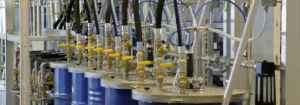Air motors, while offering several advantages like high starting torque and lightweight construction, can be challenging to regulate their speed precisely. This is due to factors such as varying air pressure, load changes, and the inherent characteristics of rotary air motors.
Methods of Speed Regulation
- Pressure Control: This remains the most common and straightforward method. By adjusting the air pressure supplied to the motor, you can control its rotational speed. A pressure regulator or valve is used to achieve this.
- Proportional-Integral-Derivative (PID) Control: For more precise control, PID controllers can be used to continuously adjust the air pressure based on the motor’s speed error.
- Pressure Sensors: Accurate pressure sensors are crucial for effective pressure control. They provide feedback to the controller, allowing it to make informed adjustments.
- Variable Displacement: While less common, some air motors have the capability to adjust their displacement, effectively changing the volume of air that the motor can handle per revolution. This can be done mechanically or electronically.
- Swashplate Mechanisms: In mechanically adjustable motors, a swashplate mechanism can be used to vary the displacement. By tilting the swashplate, the volume of air delivered to the motor can be controlled.
- Electronic Control: In electronically controlled motors, valves or actuators can be used to adjust the displacement based on electrical signals.
- Electronic Controllers: Modern electronic controllers offer the most advanced and precise speed regulation capabilities. They monitor the motor’s performance, such as speed and load, and adjust the air supply accordingly.
- Closed-Loop Control: Electronic controllers often employ closed-loop control, where the controller compares the desired speed to the actual speed and takes corrective action.
- Feedback Devices: Tachometers, encoders, or other feedback devices are used to measure the motor’s speed and provide input to the controller.
- Gearboxes: Using gearboxes can effectively reduce the output speed of an air motor, providing a more controlled and slower rotation.
- Gear Ratios: By selecting the appropriate gear ratio, engineers can achieve the desired output speed for specific applications.
- Backlash Reduction: Precision gearboxes with minimal backlash can improve the accuracy of speed regulation.
Factors Affecting Speed Regulation
- Load Changes: Fluctuations in the load on the motor can significantly affect its speed. A heavier load will tend to slow down the motor, while a lighter load will allow it to accelerate.
- Air Pressure Variations: Changes in the air pressure supplied to the motor can also impact its speed. A higher pressure will generally result in a faster rotation, while a lower pressure will lead to a slower one.
- Motor Design: The design of the air motor itself plays a role in its speed regulation characteristics. Some motors may be more sensitive to pressure changes or load variations than others.
- Friction: Internal friction within the motor can affect its speed. Reducing friction through proper lubrication and design can improve speed regulation.
Applications
Precise speed regulation of air motors is essential in various applications, including:
- Robotics and automation: For precise movements and positioning of robotic arms and components.
- Machine tools: To control the speed of spindle motors and other equipment for accurate machining.
- Material handling equipment: For precise positioning and control of conveyors, lifts, and other material handling systems.
- Agricultural machinery: For controlling the speed of planting, harvesting, and other agricultural equipment.
- Medical devices: For precise control of medical instruments and equipment, such as surgical drills and pumps.
By understanding the methods of speed regulation and the factors that influence it, engineers and technicians can effectively control the performance of air motors in these and other demanding applications.
For further insights and detailed technical information, consult the Pocket Guide to Air Motors by Atlas Copco or Contact us directly.


